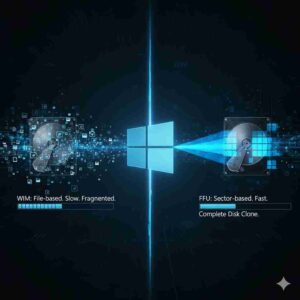When it comes to deploying Windows on a wide scale, time is money. IT workers are always looking for ways to cut down on the time it takes to image new computers or fix old ones. The Full Flash Update (FFU) image format is a powerful and frequently considerably faster successor to the old Windows Imaging Format (WIM). FFU is a game-changer that radically changes the way things are done, going from a file-based copy to a fast, sector-based disk clone. It was created to make manufacturing and deployment easier. This article talks about the unique benefits of the FFU format and how it speeds up the process of deploying Windows by a lot.
The Speed Advantage of FFU vs WIM
WIM: Imaging Based on Files
A WIM file is a type of image file. The system treats a WIM image like a zipped folder when it is applied. It takes files and directories one at a time and copies them to the disk partition where they will be used. This method is adaptable because it may be used on partitions of varying sizes, but it is sluggish by nature because it requires a lot of file system operations, checks, and metadata handling for each file.
FFU: Imaging by Sector
On the other hand, the FFU format is a sector-based image. It takes a picture of the whole physical drive, including the Windows, recovery, and system partitions, as one long block of data. When you deploy an FFU, the data is written directly to the destination drive sector by sector. This is far faster than extracting files one by one. It is basically a copy of the whole disk.

Workflow for Faster Deployment
Because FFU is based on sectors, it makes the deployment process more efficient, especially in places with a lot of work, like corporate IT or production floors.
Capture and Deployment of the Whole Disk
FFU makes managing partitions more easier because it captures and applies all of them at once. When you deploy the FFU, you don’t have to bother about making separate system, MSR, and Windows partitions. It accomplishes it for you. This one-size-fits-all method cuts off a lot of steps from a normal job sequence, which lowers the amount of work that has to be done and the number of possible failures. The time saved during the “Apply OS” phase alone can be huge. On modern hardware, it takes less than 5 minutes to cut an image application.
Overall Idea
The Windows FFU image format is a big step forward in imaging technology since it focuses on speed and efficiency for full-disk duplication. It has a bigger file size than a compressed WIM, but its sector-based cloning makes it more faster to deploy or re-image, making it the best solution for businesses who need to do so quickly. Using FFU, IT organizations may save personnel expenses by a lot, speed up the time it takes to get devices back to work, and keep a fleet of Windows devices that is flexible and up to date.
Upgrade your experience — switch to the latest version of Windows now!






